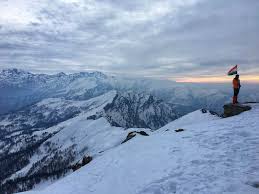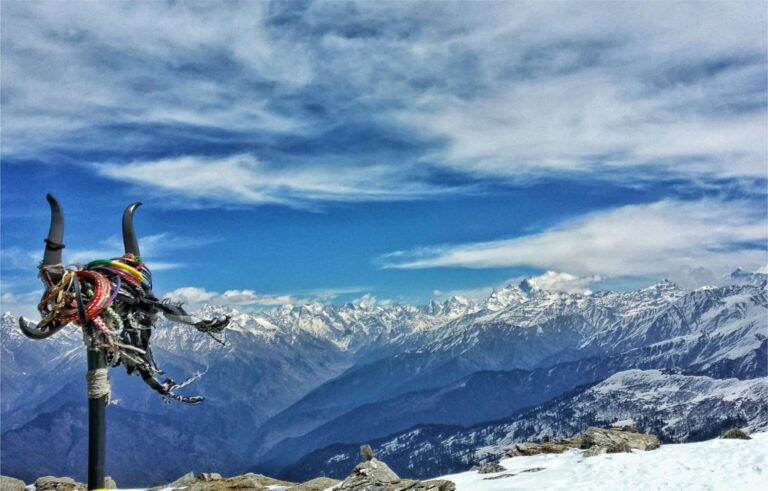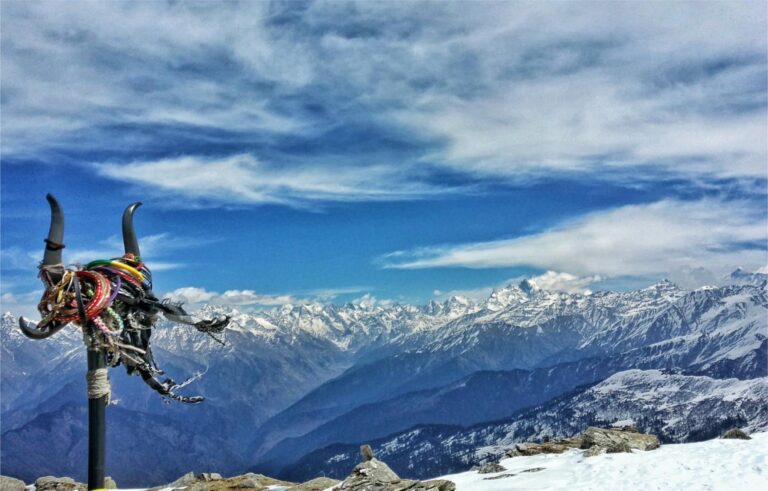The Kedarkantha Trek, also known as the queen of winter treks, is a blend of experiences that combine the beauty of the Himalayas with its challenges. This stunning winter trek in Uttarakhand offers snow-covered landscapes, scenic trails, and breathtaking summit views, making it one of the most popular winter treks in India.
Overview
The trek begins from a beautiful village, Sankri, where you can experience the local village life. Witness the beauty of Juda Ka Talab, which is even more enchanting in winter when it is frozen. A mythological story attached to it adds a mystical touch to your journey. The Kedarkantha summit offers noteworthy views, providing a 360-degree panorama of the Himalayan range, including peaks like Swargarohini, Bandarpunch, Black Peak, and Draupadi ka Danda 2. You'll also get a stunning view of Har Ki Doon Valley, Rupin Valley, and the Gangotri and Yamunotri mountain ranges.

Itinerary
Day 1: Drive from Dehradun to Sankri (220 km | 10 hrs)
Begin your journey from Dehradun to Sankri, a scenic Himalayan village. Enjoy mesmerizing views of Mussoorie, pine forests, and the winding roads of Uttarkashi. After arriving, check in, explore the village, and enjoy a local dinner. Overnight stay at Sankri.
Day 2: Sankri to Juda Ka Talab (4 km | 9100 ft | 4 hrs)
Trek through dense pine and maple forests to the picturesque Juda Ka Talab, a high-altitude lake. The serene campsite is perfect for stargazing and capturing stunning night sky views. Overnight stay in tents.
Day 3: Juda Ka Talab to Kedarkantha Base Camp (4 km | 11,250 ft | 3 hrs)
A gradual ascent through oak forests leads to the Kedarkantha base camp, where panoramic views of Swargarohini, Bandarpoonch, and Kala Nag await. Spend the evening soaking in the Himalayan beauty. Overnight stay in tents.
Day 4: Summit Kedarkantha Peak (12,500 ft) & Descend to Hargaon Camp
Start early for the summit push! The steep yet rewarding climb offers a 360-degree view of Uttarakhand's snow-clad peaks. Visit the small temple at the top before descending to Hargaon for an overnight stay.
Day 5: Descend to Sankri & Drive to Dehradun
Trek back to Sankri through pine forests, followed by a drive to Dehradun. Depart with unforgettable memories of the Himalayas!

The Route
The trek starts from Sankri (6,400 ft) and proceeds through dense pine and maple forests to reach Juda Ka Talab (9,100 ft), a beautiful high-altitude lake. From there, the trail continues to Kedarkantha Base Camp (11,250 ft) through oak forests with panoramic views. The summit day involves an early morning steep climb to Kedarkantha Peak (12,500 ft), followed by a descent to Hargaon Camp. The final day includes a trek back to Sankri through pine forests before returning to Dehradun.
Highlights Along the Way
- Panoramic 360-degree views of major Himalayan peaks from the summit
- Enchanting frozen Juda Ka Talab lake in winter months
- Beautiful campsites surrounded by pine and oak forests
- Mesmerizing sunset and sunrise views during the trek
- Opportunity to experience local Himalayan village life in Sankri
- Perfect beginner-friendly winter trek with snow-covered landscapes
Best Time to Visit
The best time to visit the Kedarkantha Trek is from November to April. During these months, the trail is blanketed in snow, creating a magical winter wonderland. Clear skies reveal snow-covered peaks such as Swargarohini, Bandarpunch, Black Peak (Kalanag), and more. For those who prefer milder weather, the spring months of March to April are ideal. The landscape transforms as the forests come alive with new growth, and Juda Ka Talab takes on a mesmerizing mirror effect.
Difficulty and Preparation
The Kedarkantha trek is considered an easy to moderate trek, making it one of the best treks for beginners. While the trail is well-marked, the final ascent to the summit is steep and requires a good level of fitness. With proper acclimatization and pacing, the trek is manageable even for first-time trekkers. It's recommended to engage in cardiovascular exercises like running, cycling, or swimming for at least a month before the trek to build stamina. The summit day involves a steep climb, so practicing stair climbing with a loaded backpack can be beneficial.

Accommodation
Accommodation during the Kedarkantha Trek includes a hotel stay in Sankri village on the first night and camping in tents for the remaining nights. The campsites at Juda Ka Talab, Kedarkantha Base Camp, and Hargaon are set up in picturesque locations with stunning views. Tents are typically on a sharing basis (2-3 people per tent) and come with sleeping bags and insulated mats suitable for sub-zero temperatures. The camping experience allows you to fully immerse in the wilderness and enjoy stargazing on clear nights.
Local Culture
The trek passes through the culturally rich region of Uttarakhand, where you can experience the unique traditions of Garhwali people. Sankri village offers a glimpse into the simple mountain lifestyle, with traditional wooden houses and friendly locals. There's a small temple at the Kedarkantha summit that holds religious significance for the local communities. The region is known for its folk tales and legends, including stories about the frozen Juda Ka Talab lake, which adds a mystical dimension to the trek.
Conservation
The Kedarkantha Trek falls within the Govind Wildlife Sanctuary and National Park, which is home to diverse flora and fauna. Trekkers are expected to follow responsible trekking practices to minimize their environmental impact. This includes carrying back all non-biodegradable waste, avoiding plastic usage, staying on marked trails to prevent soil erosion, and not disturbing the wildlife. Many trek operators in the region participate in eco-conservation initiatives and employ local guides to support the community while ensuring sustainable tourism practices.
Frequently Asked Questions
Is Kedarkantha suitable for beginners?
Yes, Kedarkantha is an ideal trek for beginners due to its gradual ascent, well-marked trails, and moderate altitude. The trek doesn't have any technical sections and can be completed by anyone with basic fitness levels.
When is the best time to see snow at Kedarkantha?
The best time to experience snow at Kedarkantha is from late December to early March. During this period, the trail is covered in a thick blanket of snow, creating a winter wonderland experience.
Is there network connectivity during the trek?
Network connectivity is limited during the trek. You might get patchy signals at Sankri village, but once you start trekking, expect to be disconnected. It's advisable to inform family and friends about your limited connectivity beforehand.
What is the difficulty level compared to other treks?
Kedarkantha is generally considered an easy to moderate trek, making it perfect for beginners. The final summit climb is steep but manageable with proper pacing. It's less challenging than treks like Rupin Pass or Har Ki Dun but offers similar scenic beauty.
Can I do this trek with my children?
Yes, Kedarkantha is suitable for families with children aged 10 and above who enjoy outdoor activities. The gradual ascent and reasonable distances make it manageable for children, but parents should ensure kids are prepared for the weather conditions and basic trekking requirements.
Trek Information
Location
Uttarakhand, India
Duration
5 days
Difficulty
Easy to Moderate
Best Season
November to April
Group Size
8-15 people
Max Altitude
12,500 ft
Start & End Point
Sankri
Inclusions & Exclusions
✅ Included:
- ✔Accommodation (Hotel in Sankri, tents during the trek)
- ✔Meals (Breakfast, Lunch, Dinner – Veg)
- ✔Trek permits & entry fees
- ✔Experienced trek leaders & guides
- ✔Camping gear (tents, sleeping bags, mats)
- ✔Transport from Dehradun to Sankri & return
❌ Excluded:
- ✖Personal expenses & trekking gear
- ✖Insurance & emergency evacuations
- ✖Bottled water & beverages
- ✖Anything not mentioned in inclusions
What to Pack
- Sturdy waterproof trekking shoes with good ankle support
- Warm layers including thermal inner wear, fleece jacket, and down jacket
- Waterproof gloves, woolen cap, and neck gaiter/balaclava
- Trekking pants (avoid cotton) and waterproof pants for snow
- UV protection sunglasses and sunscreen (snow reflection can cause sunburn)
- Headlamp with extra batteries
- Personal medical kit with altitude sickness medication
- Trekking poles for stability in snow
- Water bottles and water purification tablets
Weather Conditions
Winter (November-February)
Daytime temperatures 5 to 10°C, night temperatures can drop to -5 to -10°C, heavy snowfall expected
Early Spring (March-April)
Daytime temperatures 10 to 15°C, night temperatures around 0 to 5°C, snow begins to melt
Pre-Winter (October)
Daytime temperatures 10 to 15°C, night temperatures 0 to 5°C, possibility of early snowfall
Food & Cuisine
During the trek, all meals are provided and typically include nutritious vegetarian food. Breakfast usually consists of porridge, upma, poha, or paratha with tea. Lunch is often packed and includes items like sandwiches, rolls, or parathas with pickle. Dinner at the campsite features rice, dal, vegetables, chapati, and sometimes a dessert. Hot beverages like tea and soup are regularly served to keep trekkers warm, especially in the cold winter conditions.
Local Specialties:
- Mandua ki Roti - Nutritious flatbread made from finger millet
- Jhangora ki Kheer - Sweet pudding made from barnyard millet
- Aloo ke Gutke - Spicy potato dish with local herbs
- Kafuli - Spinach and fenugreek leaves preparation
- Garhwali Dal - Local lentil preparation with unique spices
